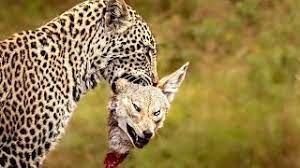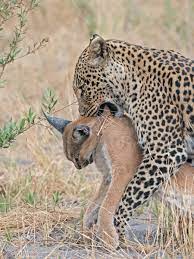In response to questions about jackal predation, I was told: “Vermin have got out of control since farmers began to drive around in their bakkies all day and don’t walk with their dogs or horse ride through the camps, checking fences and keeping an eye on the stock … that’s how vermin got out of control.”
Without innovation and the creation or discovery of new solutions, many of the risks being faced by the current generation of farmers, will indeed remain unmitigated with the real possibility of these becoming intractable, and devolving into permanent, negative features of the South African farming landscape. Stock-theft and predation by animals referred to as vermin or pests (“ongediertes” in Afrikaans – directly translated as “unwanted animals”), continue to generate huge losses for sheep farmers. These predators include lynx / caracal, jackal, baboons, bushpigs, leopard and even ratels. The farming community in general, and sheep farmers in particular have over the years, gone to great lengths, and spent countless hours and millions of rands in research, experiments and the application of mitigation strategies. For example, a decade ago now, between September 2012 and mid-January 2013, a total of 180 camera stations were set up on approximately 80 000 hectares, covering seventeen sheep farms in the Laingsburg and Beaufort West Districts of the Karoo. Thousands of kilometers of mostly gravel, farm roads was travelled by the research team from the CSSR and UCT. To what end all this effort? Where are the fruits of this labour? (A full report can be downloaded at https://www.ncbi.nlm.nih.gov/pmc/articles/PMC7128017/ and is also available in the Ambio Journal, volume 49(6) of June 2020.)
The costs involved in losing a single sheep
To set the scene for the discussion of the problems and costs confronting sheep farmers when faced with “the predator problem”, it is important to consider what the loss of a sheep through predation, entails. Calculating the total value of the loss of a sheep as a production unit due to predation, or theft for that matter, must include costs such as the originating breeding or insemination costs, supplemental feeding of the pregnant ewe, animal health care costs, lambing and rearing costs of the predated animal, grazing and water costs, all associated labour and energy costs related to the predated sheep, the future value of the mutton or wool of the now predated sheep, other lost opportunity costs, and loss of cash-flow, the time of the farmer or manager, to note the more obvious. It is clear that there are most often considerable costs involved in the loss of just a single sheep.
The Black-backed Jackal and Caracal (rooikat)

Photos: leopard with a jackal, and (below right) with a rooikat.
The Black-backed Jackal in the Rosmead / Schoombee area is now so serious that the local farmers have taken to the skies and hire helicopters and professional hunters to fly through the area hunting jackal. Yet despite the introduction of this extremely expensive mitigation measure together with regular hunts by day and night, with night-sights and dogs, trapping, and the setting out of poisoned bait, predation by jackals and caracal on these farms continues to grow at an alarming rate. Many farmers in this district seem ready to accept as a fait accompli, that “no solution for the Jackal Problem exists” and that “all possible solutions and interventions have been exhausted”. It is worth being reminded that when it comes to risk mitigation in farming, there is no single, silver bullet, there exists no one solution to address all the aspects associated with even just one risk such as predation by jackal and caracal. Sustainable risk mitigation in sheep farming should be an ongoing focus of attention where new ideas are continually added to the menu, then implemented and tested for the desired results. As noted, the mitigation of risk underpinned by a strong focus on innovative solutions is the core theme of this series of articles. Allow me to “throw my hat into the ring” on the issue of the predation problem by presenting what is an extreme idea – leopards!
Leopards vs jackals and caracals
With regards to the risk presented by especially jackal and rooikat on and around sheep farms, the fact that leopards have all but been removed from the Karoo eco-system as top predator, lies at the heart of the problem. Mother Nature has filled the gap left by the leopards, replacing the spotted cat with jackal and rooikat. Further, many decades of hunting and trapping has removed the genetics of the less smart canines and felines, leaving only the most cunning to continue to breed. The smartest jackals and rooikat now find themselves atop the food pyramid of the veld in much of the Karoo.

Has any sheep farming district in South Africa tested the impact of the reintroduction of leopards on the following:
- jackal and rooikat numbers,
- predation by jackal and rooikat on sheep with leopard present in the district, and
- predation on sheep by leopard?
From the perspective of the risk mitigation of losses of livestock through predation by jackal, the maths is firmly in favour of leopards! Jackals become sexually mature at eleven months, gestate for 60 days, and then produce litters of up to nine pups. The average mortality rate of jackal pups is a relatively low 40%, where those which survive into their second year can expect to have lifespans of between six and eight years. Leopards mature sexually at 24 – 28 months but rarely mate before their third year, most often producing only one or two cubs. Cub and juvenile mortality rates among leopards is high at 65%. In the wild, the lifespan of leopards is between ten and twelve years. Hunting of leopards was only suspended in South Africa in 2016, where it remains listed as a “threatened species”. Rather a single, territory-bound leopard on the property than possibly three or four breeding pairs of jackal, and any number of nomadic, sub-adults or single, non-breeding adults.
To my mind the mathematics around choice of risk mitigation strategy is firmly behind the leopard where its reintroduction into a jackal and rooikat infested areas as top predator would see the numbers of the second-tier predators decline sharply with the associated decrease in loss of sheep and other livestock due to predation. Of course it would be imperative to ensure the overall health of the eco-system, with sufficient numbers of primary, wild prey species for leopard being available for the reintroduced top predator. Regular patrols of fence-lines, grazing camps and lambing areas would be imperative. The re-introduction of leopards as a proposed mitigation measure requires much more serious research and testing by participating farmers, together with the rehabilitation of “wild, unfarmed areas” in farming districts. Does the ‘out-of-control’ Predator Problem warrant the further investigation of this seemingly drastic mitigation measure?
Other strategies
A number of farms in the Nieu-Bethesda area follow a different “Jackal Control” strategy which is part of a broader, holistic approach to farming based on the re-establishment of balance within the eco-system. There is at least anecdotal evidence to support the further investigation, research and documentation of the “no hunting, no shooting” policy towards jackal and rooikat, as it is reported to have delivered dramatic decreases in predation on sheep and lambs by these two species. Another strategy which has reported success is based on the prohibition of hunting on farms by staff using dogs. The thinking is that if the numbers and variety of the wild and preferred prey species of jackal and caracal, such as hares, ground squirrels, meerkat, rodents, reptiles, insects, birds, young antelope, and even certain fruit in the case of jackal, are left undisturbed, the predators will have no need to target domestic livestock as their traditional food sources will be plentiful. The counter argument is that predators will always select “easier” prey with energy conservation and lower risk of injury being the two key motivations, with sheep being slower than “springhaas” (springhares) and not being armed with dangerous, piercing horns as do most buck species. Supporting the approach of ‘less shooting, and more research’, in an interesting article titled “Superdogs”, the author Don Pinnock, after field-research and interviews with experts involved in “pest-control” programmes, came to the following conclusion: “We now have a sheep farmer’s worst nightmare – a predator which thrives on persecution. By fast-tracking natural selection, we’ve produced a superdog” (Africa Wild Forum, 19 June 2021.) Further investigation is warranted to follow up and document if and how these alternative risk mitigation strategies are working.
“Management-by-walking-about” was once a popular method of keeping ones finger on the heartbeat of a business! Short of the erection of eight-foot, solar- or generator-powered, double reinforced, electric fencing at the cost of a small farm, seemingly the only feasible mitigation strategy to combat predation, illegal hunting, poaching and other unwanted, uninvited visitors to the farm will be twice daily physical patrols of high risk areas on horseback, carrying a licensed firearm together with trained security dogs. Oh, and don’t forget the leopards !!

If you would like to communicate directly with the author, you are invited to contact PJ at the following email address: [email protected]
Feature photo by Juanita Swart on Unsplash. Other photos used courtesy of PJ Momsen
Relevant Agribook pages include “Wildlife on Farms“
